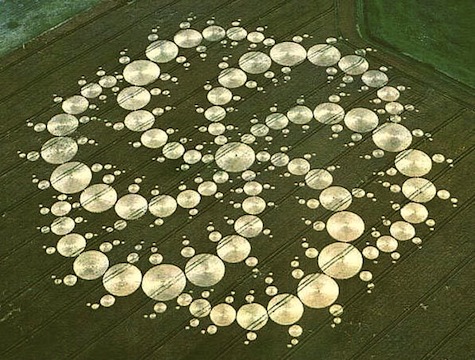 Intelligent Design
Intelligent Design
Crop Circles as an ID Test

The widespread prank of creating patterns in crops at night provides a test of intelligent design theory.
There are some who still try to explain crop circles by natural causes. Others invoke space aliens. Most of us by now are convinced that pranksters do this as a hobby. But how can we know?
On Live Science, Benjamin Radford discussed the history of the crop circle phenomenon. Right near the top is a photo of a very elaborate creation consisting of 409 circles in a fractal spiral — a far cry from the initial pranks that were simply plain old circles.
According to some estimates, crop circles appear every week somewhere around the world. The strange circles and patterns appear mysteriously overnight in farmers’ fields, provoking puzzlement, delight, and intrigue for both locals and the news media. The circles are mostly found in the United Kingdom, but have spread to dozens of countries around the world in past decades. But who — or what — is making them?
Radford argues that the phenomenon cannot be found for certain in ancient literature. It began at a particular time:
In fact the first real crop circles didn’t appear until the 1970s, when simple circles began appearing in the English countryside. The number and complexity of the circles increased dramatically, reaching a peak in the 1980s and 1990s when increasingly elaborate circles were produced, including those illustrating complex mathematical equations such as fractals.
Readers who were around then remember the initial flurry of excitement at the phenomenon, wondering if some natural cause — weird weather, electromagnetic vortex or animal behavior — was responsible. The more elaborate they became, though, the more people intuitively suspected human activity at work. Sure enough, two hoaxers in 1991 fessed up.
But does that nail the explanation? It might be that only some of the circles are manmade. This is where intelligent design theory can provide some clarity. It states that chance and natural causes need to be ruled out first. Then, when specified complexity is found, the inference to the best explanation is intelligent design — the activity of a mind. But it cannot distinguish between human minds and other kinds of mental activity. It cannot rule out space aliens, for instance.
Radford is probably not an advocate of intelligent design, but he applied some forensic data to render it improbable that natural causes are behind the crop circle phenomenon. For one, they almost always involve circles. Natural causes can create circles, too, but he notes that circles are the easiest forms for hoaxers to make. A few crop circles involve triangles, rectangles and squares — also relatively easy to construct, but rarely found in nature on that scale.
In addition, they are almost always created at night by forces that are camera-shy and seem to take pains to leave no human trace. One last clue is that they are usually made near roads where they can be seen. If natural causes were at work, why are they not found in remote fields of wild grass? Here’s Radford’s conclusion:
There are many theories about what creates crop circles, from aliens to mysterious vortices to wind patterns, but they all lack one important element: good evidence. Perhaps one day a mysterious, unknown source will be discovered for crop circles, but until then perhaps they are best thought of as collective public art.
So while he cannot rule out non-human explanations, Radford puts the burden of proof on those who allege them. He has, in a sense, worked his way through Dembski’s explanatory filter. Having found chance and natural causes highly improbable, he landed on the only remaining explanation: intelligent activity. Since human intelligence is probably the only kind he would admit, that’s his favored view: “public art.” Agreed. It’s hard to see any reason a space alien, an angel, or a god of anyone’s imagination would suddenly start making circles in 1970 by roadsides. And they are real:
Unlike other mysterious phenomenon such as psychic powers, ghosts, or Bigfoot, there is no doubt that crop circles are “real.” The evidence that they exist is clear and overwhelming. The real question is what creates them.
Remember that intelligent design theory is very limited in its aim. It doesn’t ask who the designer is. All it can differentiate is natural from intelligent causes. Identifying the designer of crop circles requires further sleuthing and more evidence. But a legitimate inference can be made to design even without the benefit of catching the designer at work via a camera or a confession. If there’s low probability and specification, it’s design.
Crop circles, therefore, provide an interesting case where non-ID scientists typically infer design as the best explanation instead of limiting themselves to methodological naturalism (see the November 14, 2011 entry). Let’s continue to argue they should use that same reasoning when looking at codes and machines in living organisms.
Image: Crop circle, Milk Hill, England, 2001/Wikipedia.
